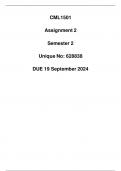CML1501
Assignment 2
Semester 2
Unique No: 628838
DUE 19 September 2024
, Question 1
(a)
In delict, the element of fault refers to the blameworthiness of the defendant’s
actions, and it can manifest as either intention (dolus) or n egligence (culpa).
Intention involves the deliberate commission of a wrongful act with the knowledge
and desire to cause harm, whereas negligence occurs when a person fails to act
with the level of care that a reasonable person would in the same circumstan ces,
resulting in harm. The existence of fault, whether by intention or negligence, is
necessary for liability in delict, as it establishes the culpability of the defendant.
(b)
In delict, "damage" refers to the actual harm or loss suffered by the plaintiff as a
result of the defendant's wrongful act. This can include pecuniary loss (e.g., medical
expenses, loss of income) or non-pecuniary loss (e.g., pain and suffering, emotional
distress). For example, in the case of Mankayi v Anglogold Ashanti Ltd [2011] ZACC
3, the court dealt with damages related to health issues caused by working
conditions, where the plaintiff suffered personal injury due to the employer's
negligence.
(c)
"Damages" in delict refers to the monetary compensation awarded to a plaintiff for
the harm suffered due to the defendant’s wrongful act. It serves to place the injured
party in the position they would have been in had the delict not occurred. For
instance, in Minister of Safety and Security v Van Duivenboden [2002] 3 SA 946
(SCA), the court awarded damages to the plaintiff for the harm caused by the
negligent omission of the police to prevent a foreseeable crime.




